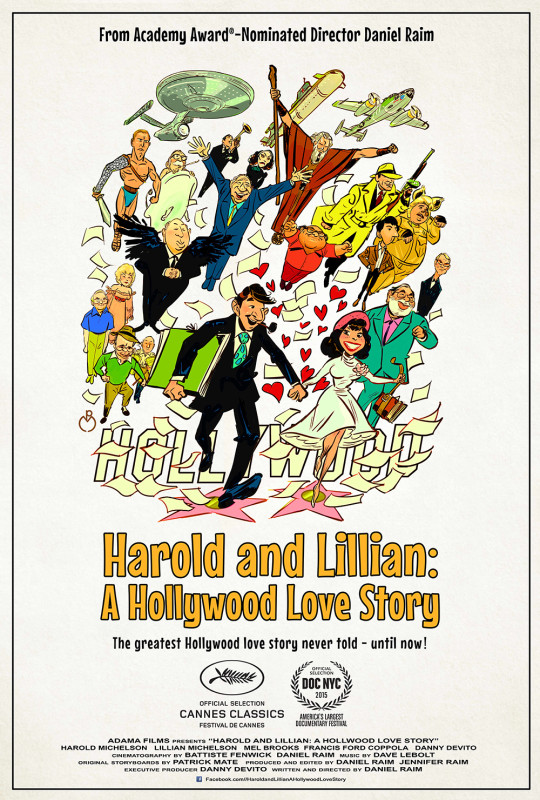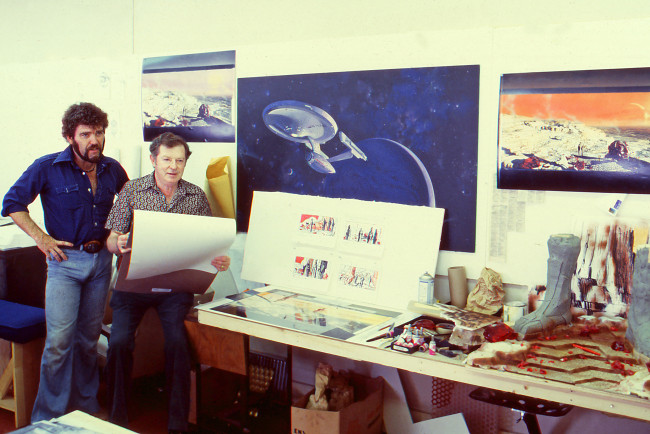By James Hancock November 15th, 2015
When discussing the luminaries of film history, too often our attention goes exclusively to the directors and the stars as if they somehow gave birth to their films by sheer force of will. I am perhaps more guilty of this than most. I tend to place great directors on a pedestal and worship them like a god, casually tossing around the ‘a film by’ credit and describing their films with possessive terminology. This attitude is a huge disservice to the thousands of craftsmen who devote their lives to working in the movie industry. They are the unsung heroes of the movie biz who rarely even get so much as a footnote in the history books and often work uncredited. Thankfully, this will not be the case for Harold and Lillian Michelson, a husband and wife creative team who are the focus of Daniel Raim’s (see I just did it again) touching new documentary Harold and Lillian: A Hollywood Love Story. The film premiered earlier this year at Cannes and opens tomorrow in New York at the IFC Center as part of DOC NYC, America’s largest documentary film festival. Unless you are a Hollywood insider you have likely never heard of Harold and Lillian, a storyboard artist/production designer and film researcher respectively, but I guarantee that you’ve heard of the films they’ve helped bring to life. Between the two of them their combined work represents six decades of filmmaking and hundreds of movies including The Ten Commandments, Ben-Hur, Spartacus, The Man Who Knew Too Much, To Catch a Thief, The Apartment, Cape Fear, The Birds, Marnie, Cleopatra, Who’s Afraid of Virginia Woolf?, Rosemary’s Baby, The Graduate, Chinatown, Johnny Got His Gun, Rocky, Star Trek: The Motion Picture, Raging Bull, History of the World Part 1, Scarface, Spaceballs, The Fly and so many more. Over the course of this documentary, it is impossible not to be moved by this inspirational story about devoting one’s life to the craft of making movies, and more importantly, what it takes to make a marriage last for 60 years in a town where marriages rarely last 60 days.
https://youtu.be/7RuCqsZhkLE
What was so compelling for me about the documentary was how the story of Harold and Lillian flies in the face of all conventional wisdom about becoming a success in the movie business. Rather than single-mindedly pursuing their dreams like egomaniacs and splitting apart at the first sign of trouble, their struggles raising three boys, one of whom suffers from autism, form the foundation of a healthy productive life together. Contrary to most true Hollywood stories, this tale offers no drug/sex scandals, no epic battles on the set, nor any other of the tropes one expects from tales from the Hollywood trenches. Sweet and wholesome are the most appropriate words I can think of for describing this documentary. The only thrills and adventure Harold and Lillian wanted out of life were found in their work. After flying 40 bombing missions as a bombardier navigator in WWII, Harold proposed to Lillian and moved them out to Los Angeles where he hurled himself into learning his draftsmanship. In those days, the movie business was still dominated by a rigid caste system and Harold slowly and diligently worked his way up through the ranks. Harold always benefited from an instinctive understanding of perspective and his obsession with the mathematics of camera lenses gave him an uncanny ability for pre-visualizing movies through his storyboards. His big break came on Cecil B. DeMille’s The Ten Commandments where some of the most iconic sequences were lifted directly from Harold’s ideas, a pattern that would be repeated frequently throughout his career. He was soon discovered by Hitchcock who used him repeatedly on his films giving Harold the chance to learn from a master how to structure his storyboards like a symphony. It did not take long for Harold to graduate to Art Direction and Production Design for which he would eventually be nominated for 2 Oscars.
As impressive as Harold’s work with ink and charcoal might be, the heart and soul of this film is Lillian Michelson. Even when discussing a macabre film about the occult like Rosemary’s Baby, her adorable style of telling stories makes it sound as if she could just as easily be discussing a litter of puppies. As an orphan she spent most of her childhood buried in books which made her a natural for curating one of the world’s best libraries on film research. Originally movie studios kept these libraries in order to be able to make any film on any topic on their backlot. But with the collapse of the studio system, Lillian’s library frequently changed hands from Paramount to AFI to Zoetrope and finally Dreamworks. Lillian speaks about filmmaking giants as if they were her own children and showers praise on David Lynch for always returning his books to where he found them when he was a student at AFI. And when it came to hard research, Lillian was incredibly tenacious. Whether she was interviewing old ladies about 19th Jewish underpants or talking to Columbian drug lords in preparation for Brian De Palma’s Scarface, she hurled herself repeatedly into every subject required of her. It seems as if every director who knew Harold and Lillian wanted to be adopted by them. During their time at Dreamworks, they were held in such high regard that they immortalized in Shrek 2 as King Harold and Queen Lillian. But the highest praise comes from directors like Mel Brooks who speaks very frankly about the deluge of ideas Harold and Lillian brought to the table to make the smallest details in a film just a little bit better. It is these crucial details that add up to a greater whole making a film what it is. Director Mike Nichols understood this and when accepting his Oscar for The Graduate made it very clear that the Oscar was the result of his very special crew. In watching this documentary, you will be astonished by just how many crucial scenes and visual flourishes from films like The Graduate flowed directly from the pen of Harold Michelson. Throughout the film, I was forced to pause and reevaluate the nature of authorship in filmmaking as I wondered just how many more Lillian and Harolds are out there working their butts off to make directors famous. So if you are in the New York area, I strongly encourage you to hunt down this highly enjoyable love song to the filmmaking process. Hopefully it will not take long before this film is available online. The film will open your eyes in ways you never anticipated and only deepen your appreciation for so many films you already know and love.
DOC NYC Festival Screenings:
Tuesday, November 17 at 9:30PM
Wednesday, November 18 at 2:45PM
(IFC CENTER- 323 6th Avenue at West 3rd Street)
I am one of the Co-Hosts of Wrong Reel and you can find more of our content here:








